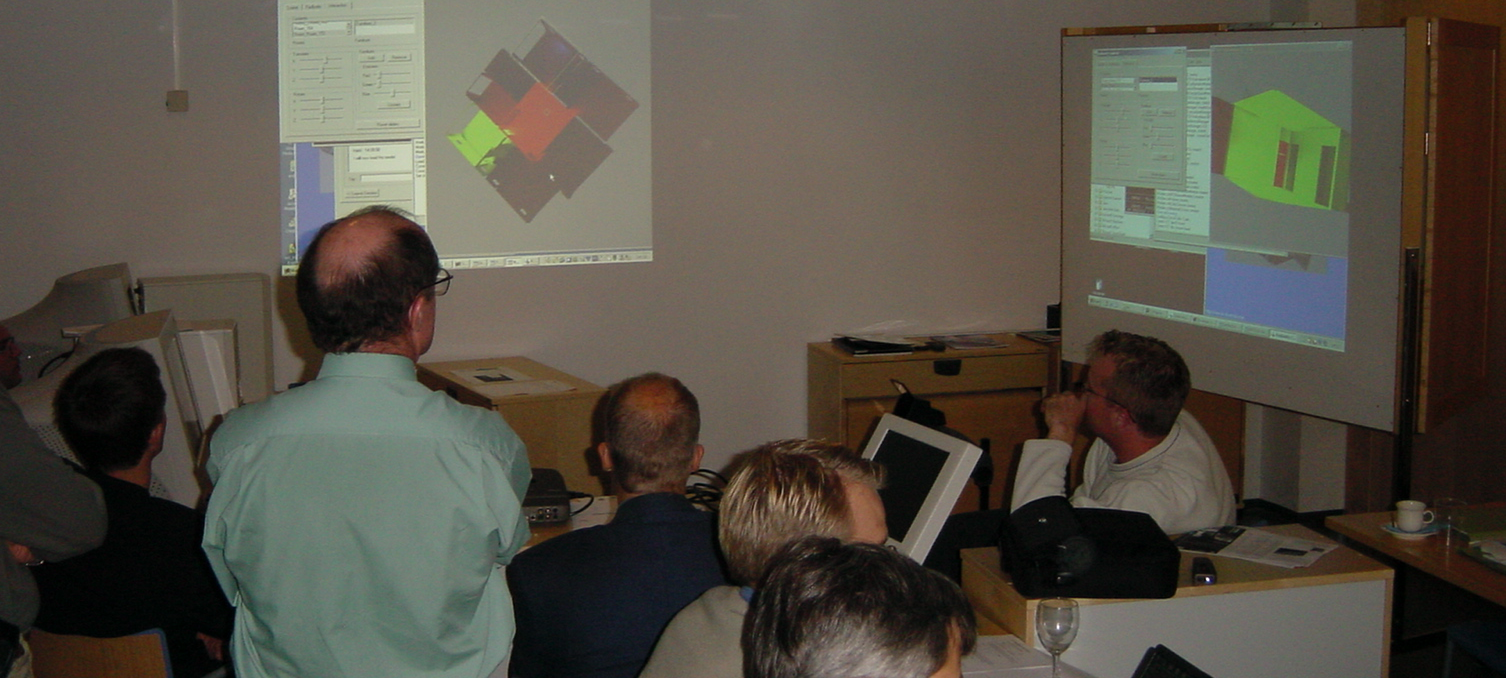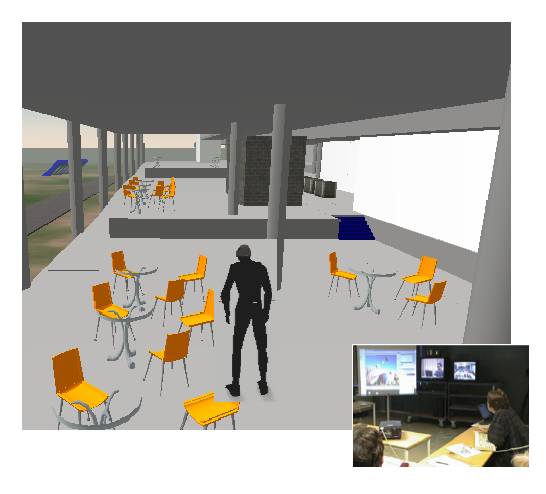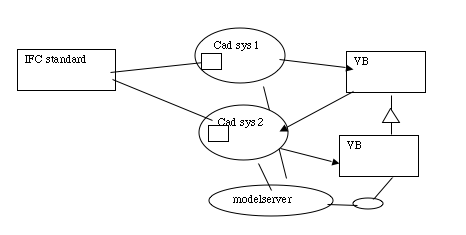|
1
|
New services in Intelligent and Responsive buildings - IB
|
Purpose:
The latest progresses within Information and Communication Technology (ICT) have provided designers and building owners/users with possibilities to formulate and test new services in buildings. The project will focus on needs and requirements formulation as well as service integration in connection with design and evaluation of new services for offices, hospitals etc. with special regard to building users wishes and needs (end-users, operation and maintenance, facility management, and administration).
|

|
Main activites:
The project will map the latest progress within ICT supported services, state-of-the-art implementations and future IB systems installations, and propose methodologies for creative Intelligent Building design and innovation.
- State-of-the art and historic background
- Service descriptions (and Ontologies) on application (business) and technological levels
- Design considerations and changed methodologies in connection with building and IB systems innovative design.
- Proposals on a mixed reality virtual platform to support building users and service providers in creative Intelligent Building design and innovation.
- Future scenarios on user services in Intelligent and Responsive buildings.
Contact person: Per Christiansson, Kjeld Svidt
| Theory: 2 (max 3) |
Experimental Work: 1 (max 3) |
Computter Modelling: 2 (max 3) |
|
|
2
|
User participation in innovative building design
|
Purpose:
During the late years there has been an ever-increasing focus on the possibilities to change the building process to raise quality on the final building products as well as the activities of actors involved in the building process. One reason for this interest is the new opportunities evolving due to introduction of advanced ICT. The project will focus on creative changes of the building process powered by user driven innovation activities. Special attenttion will be given to innovative methods used in Virtual Worlds settings where building end-users can collaborate in asynchrounous or synchrounous modes on building models in different representations from symbolic to very realistic models. Important contributions to innovative user driven innovations methods are expected in terms of technical support strengths, weaknesses, opportunities and threats (SWOT).
|

|
Main activites:
The project will map and describe the latest progress within ICT supported virtual worlds access and implement a Virtual Reality supported test case for user driven innovative design.
- State-of-the art and historic background on ICT supported Virtual Worlds.
- User driven innovation methods overview and analyses, partly based on discussion with Danish companies on experiences within the area.
- Design and implementation (including user needs and requirements capture) in Virtual Reality Panorama and CAVE of an innovative user-driven design methodology (in collaboration with VRMediaLab AAU).
- Realization of a test case in the Virtual Reality environment.
- SWOT analysis on own implemenation supported by collected international experiences.
- Suggestions for improvement of innovative design methodologies and arguments for these improvements.
Contact person: Per Christiansson, Kristian Birch Sørensen
| Theory: 1 (max 3) |
Experimental Work: 2 (max 3) |
Computter Modelling: 2 (max 3) |
|
|
3
|
Future information technology at the construction site
Purpose:
In recent years, the construction industry has started changing from traditional 2D CAD drawings to more intelligent 3D object based models of the entire building. Such models give us a number of new possibilities for planning and controlling the activities at the construction site through advanced 4D models and possible links between the physical construction components and the virtual building model. New information and communication technology can improve the communication of correct instructions at the right time for the construction work as well as capturing information for quality assurance and as-built documentation.
The purpose of this project is to identify important problems within the area and propose solutions for future use of state-of-the-art information technology at the construction site.
Main activites:
- Identify current practices and problems in traditional construction projects
- Review of enabling technologies, software, hardware, international initiatives
- Test existing methods, software, hardware
- Identify needs and requirements for new solutions
- Build early prototypes with more or less functionality for initial tests
Contact person: Kjeld Svidt, Per Christiansson
| Theory: 2 (max 3) |
Experimental Work: 2 (max 3) |
Computter Modelling: 2 (max 3) |
|
|
4
|
Structural modelling and design coordination
Purpose:
The construction industry is changing from traditional CAD drawings to more intelligent 3D object based models of the entire building. There are many attempts to improve the structural design process by making a better connection between object based CAD systems and structural simulation tools. The simulation tools can be more or less integrated with specific CAD systems or they may exchange data through open international standards. An important issue for the structural engineer is also the often complicated coordination with requirements from other disciplines such as architecture, HVAC etc. New IT tools are introduced to assist this coordination.
The purpose of this project is to identify critical elements of the integrated design and coordination process and examine how new methods and information technology can assist us in the future construction industry.
Main activites:
- Identify strength and limitations in current practices and identify opportunities with upcoming technologies in the area
- Review of enabling Information and Communication technologies (ICT), including software, data models, international standards, and human computer interaction tools
- Examine today’s possibilities with existing tools
- Identify needs for new ways of working and from that derive a list of requirements on technical solutions
- Demonstrate possible solutions for the near future and describe issues for future development
Contact person: Kjeld Svidt, Per Christiansson
| Theory: 2 (max 3) |
Experimental Work: 2 (max 3) |
Computter Modelling: 2 (max 3) |
|
|
5
|
IFC klassifikation og Cad system

|
|
6
|
Krav på 3D-produktmodeler for simulering og analyse
|
|
7
|
Dansk web container for bygge metadata
|
|
8
|
Samarbejds- og videndelingsværktøjer til byggebranchen
|
|
9
|
Integrede projekt- og kvalitetsledelsesværktøjer
|
|
10
|
4D+5D afprøvning og videreudvikling af teknologierne
|
|
11
|
IFC-import af bygningsmodeller i virtuelle web-baserede 3D-verdener som Second Life
|
|
12
|
Integreret simulering
|
|
13
|
Business ontologier
|
|
14
|
IT i drift og vedligehold
|
|
15-23
|
- Musikkens Hus i Nordjylland (konstruktion, byggeledelse)
- Den Afrikanske Landsby, Aalborg Zoo (konstruktion)
- Flyvestation Karup - Kursus Ejendom (konstruktion/byggeledelse, indeklima/bygningsinstallationer)
- Bestemmelse af søjlers bæreevne (konstruktion)
|




